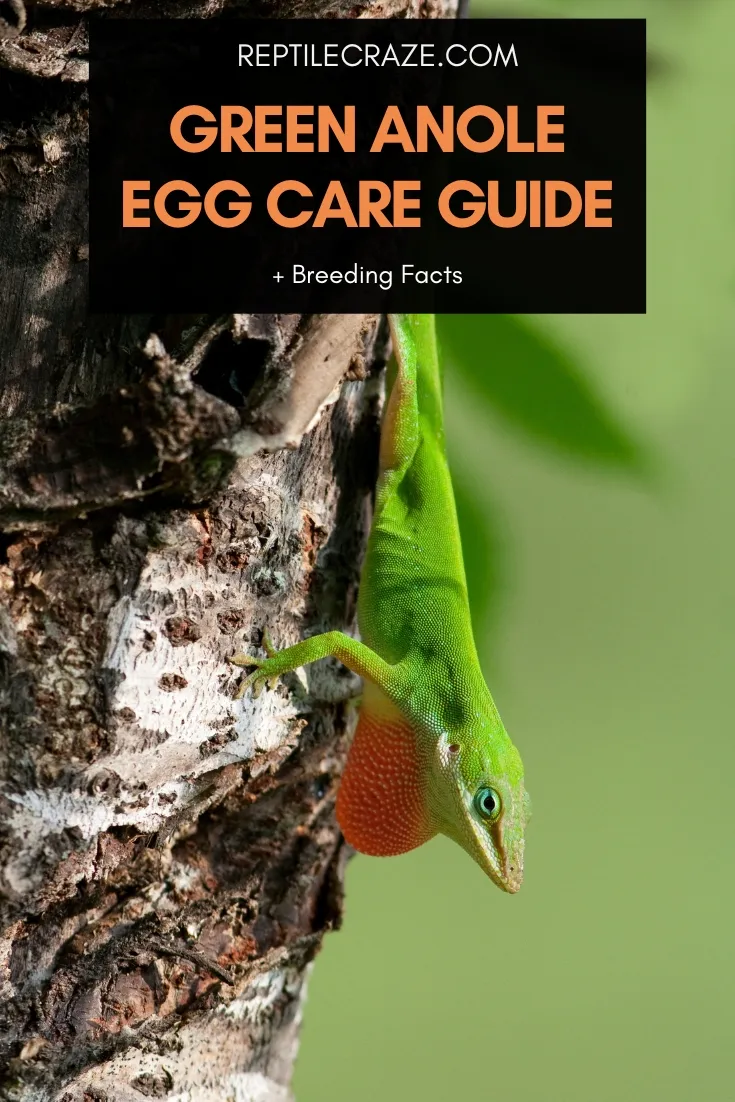
If you’re up for the challenge of breeding green anoles, you’ll soon learn that caring for their eggs can be a gratifying experience. Since they require special attention, we’ve prepared a comprehensive care guide to help you in the process.
Green anole eggs require a steady temperature of 80-85 degrees Fahrenheit, 80% humidity levels, and around 12 hours of UVB light daily. It takes approximately 5 to 7 weeks for green anole eggs to hatch.
Continue reading to learn the specifics of taking care of green anole eggs, as well as how to encourage your pets’ reproductive behavior. We’ve also prepared a checklist with the elements necessary for egg care.
Table of Contents
How Do You Take Care of Green Anole Eggs?
First and foremost, you should decide whether you want to leave the eggs in the terrarium or move them to an incubator.
Some pet owners prefer the incubator as it helps prevent the parents from damaging the eggs. This way, they also have more control over the eggs’ development.
We’ll now tell you everything about moving green anole eggs to an incubator. Nevertheless, if you think it would be best for them to remain in the terrarium, you’ll have to maintain the same temperature, humidity, and light conditions detailed below.
1. Incubation Container
If you decide to move the eggs into an incubator, you can either purchase one or create the required incubating conditions yourself.
You can use plastic boxes, deli cups, or Tupperware products as incubation containers and cover them with lids with holes that facilitate ventilation.
Check out the video below for detailed steps and information on setting up a DIY incubator.
2. Container Substrate
The substrate you settle on should be able to retain water and, therefore, maintain the required humidity levels.
Veterinarians usually recommend using vermiculite as an incubation medium. But you can also use perlite.
Add 1-2 inches of substrate to the bottom of the container and make small holes where you’ll place the eggs. The holes should be at least 0.75 inches apart.
This ensures that the egg will be lying firmly on the substrate. Don’t forget that they should be only half-buried in the substrate.
3. Move the Eggs into the Container
This is the most important part of the process. The soft-shelled eggs are quite tiny (measuring around 0.49 by 0.37 inches) so there’s a high risk of damaging them.
You should avoid turning them. Although studies show that turning reptile eggs does not significantly affect egg development or hatching success, it increases the post-birth mortality rate (37.5% in turned eggs and only 4.5% in unturned eggs).
Before moving them into the container, use a pencil to gently mark their top side. Use a plastic spoon to scoop the eggs from the terrarium and gently move them into the holes you’ve previously made in the container substrate.
3. Maintain the Required Temperature
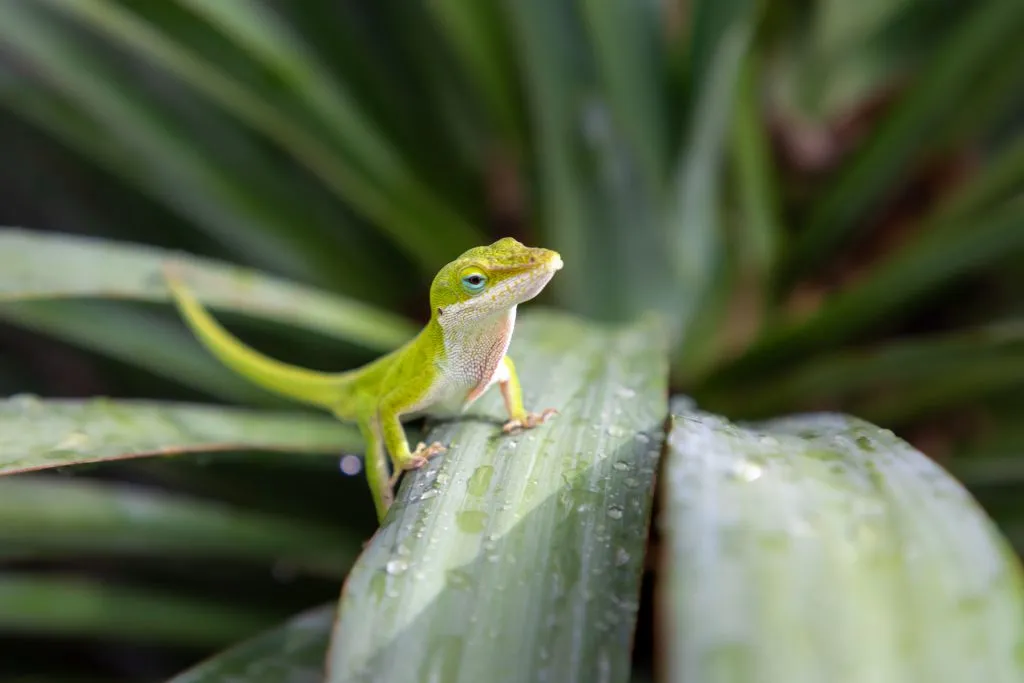
The temperature inside the container must be between 80 and 85 degrees Fahrenheit. Measuring the temperature can be done by placing a thermometer on the substrate.
If you have only one egg, place the thermometer as close as possible. If there are more, put the thermometer in the middle.
You can use ceramic heat emitters or incubator heaters to maintain the required temperature. Ensure to read the instructions carefully to avoid any electrical hazards.
It’s important for the heat to be distributed evenly around the container. Therefore, the heat source is best placed right above the box. You should adjust the distance between the container and the heat source based on the required temperature.
It’s recommended to check the thermometer every 12 hours. If the temperature drops during the night, you can temporarily cover the eggs with the substrate.
5. Maintain the Required Humidity Levels
Humidity is just as important as temperature. The incubation container must have around 80% humidity. This will facilitate the hatching process because the eggshell won’t be dry and tough.
You can set up a hygrometer inside the incubator to check the humidity levels. Maintaining the required humidity can be done by placing a small dish of water in the container or using distilled water to mist the box 2-3 times daily.
Don’t forget to check the humidity levels at least once a day to avoid fluctuations
Tip: Do you know how to find out if your green anoles is pregnant (gravid)? Read this article!
6. Sunlight and UV Light Exposure
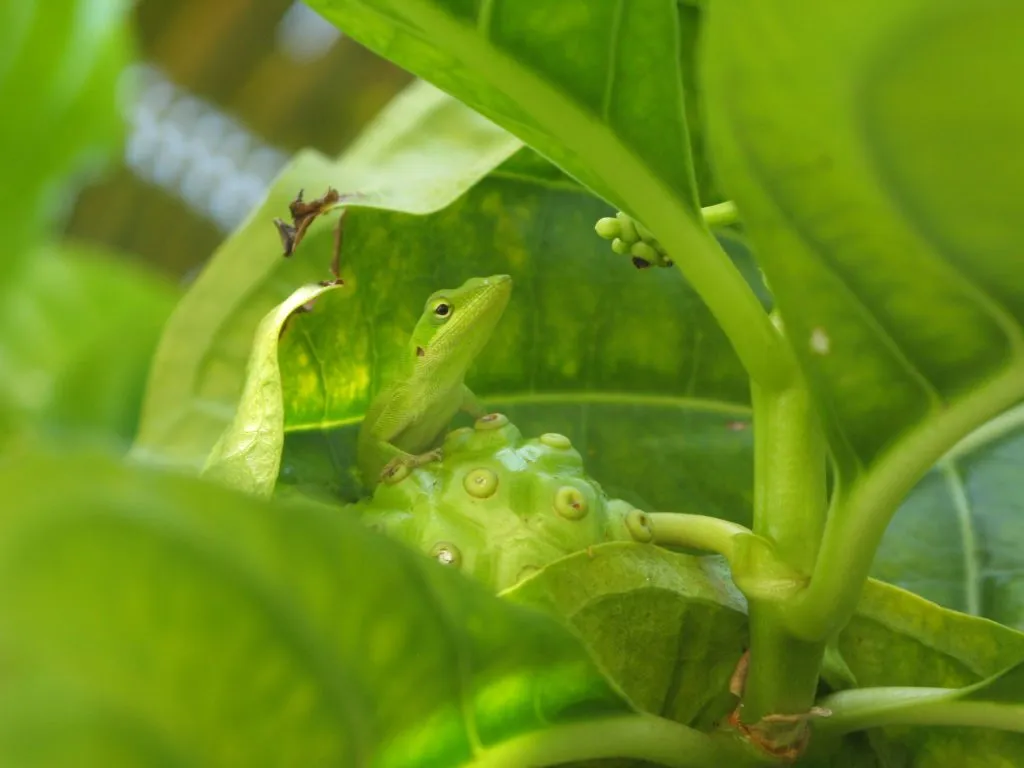
Green anole eggs require around 12 hours of UVB light daily. You should place a UVB lamp above the container. Using a timer will help you make sure the eggs get enough exposure.
If possible, you can take the box outside for indirect sunlight exposure. However, it is crucial to oversee the eggs and ensure that the temperature inside the box doesn’t rise above 85 degrees Fahrenheit.
7. Prepare for Welcoming Baby Anoles
After hatching, you should move your baby green anoles to a nursing
Make sure to keep the babies hydrated by spritzing the
A baby anole’s diet must be rich in calcium, protein, and vitamins.
The
Pinhead crickets, baby Dubia roaches, flightless fruit flies, and vegetables are excellent choices for baby anoles.
Need more info on green anoles? Here is our green anole care guide!
How Do I Tell If An Anole Egg is Fertile?
An essential step in caring for green anole eggs until they hatch (which takes 5-7 weeks or less if incubation conditions are perfect) is ensuring that the process goes smoothly.
Sometimes the eggs may develop mold, dry out, and eventually die. You should use a candle tester to determine if they’re healthy or not. Put the light close to the egg but avoid touching or moving it.
Healthy eggs have visible veins inside and a pinkish or reddish color. Infertile or dead eggs have a yellowish color.
How Many Eggs Do Green Anoles Lay?
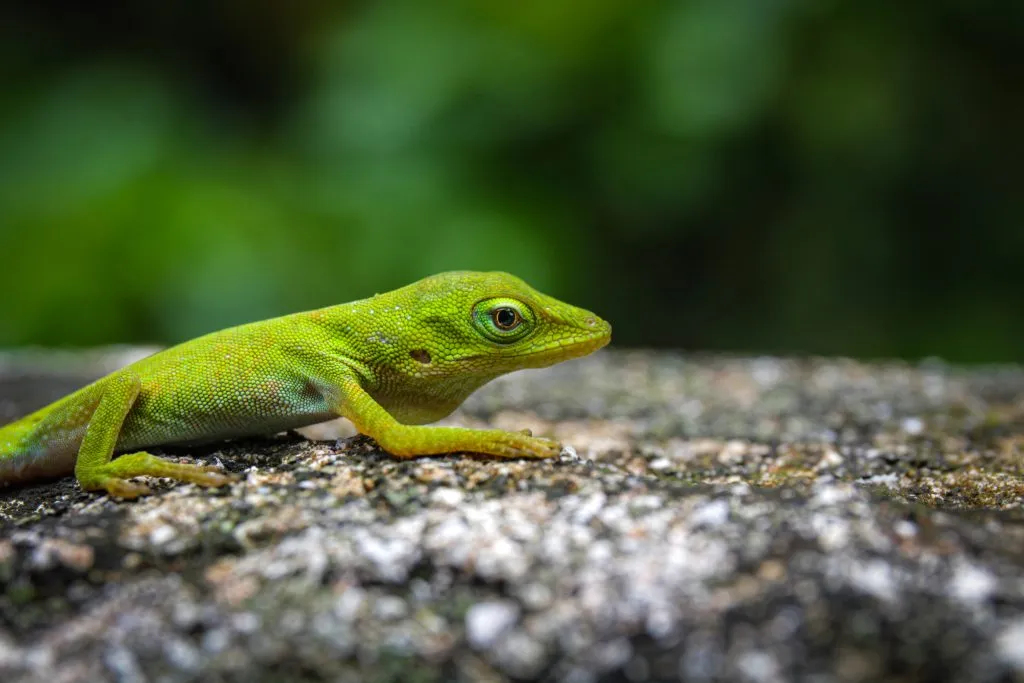
Green anoles usually lay one egg every one or two weeks from March or April to August. During this period, they can lay around 12 eggs.
However, the reproductive season can sometimes last until October, as per a study based on ten anoles.
It showed that their reproductive peak was registered in August. The green anoles were kept in captivity, but the conditions mimicked their natural environment. The average number of eggs laid in a year was 13.7.
Where Do Green Anoles Lay Eggs?
In captivity, green anoles lay eggs on or just below the terrarium substrate. The females may bury the eggs under leaf litter if the environment mimics their natural habitat.
They do the same in the wild, except that they have more “hiding” places to choose from. Females may dig a shallow depression in soft soil to bury the eggs or use rotting wood or tree holes as incubation sites.
What Do I Do If I Find An Anole Egg?
If the egg is in a safe place, you can leave it there – nature will follow its course, and the eggs will hatch.
However, if you want to take care of it yourself, you can take it home for incubation. Since you cannot easily find green anole eggs for sale, this is an opportunity for you to incubate and “raise” your baby anole (if that is allowed in your area).
Make sure you don’t rotate the egg while moving it and provide it with the required incubation conditions to ensure natural and healthy development.
Will Green Anoles Breed in Captivity?
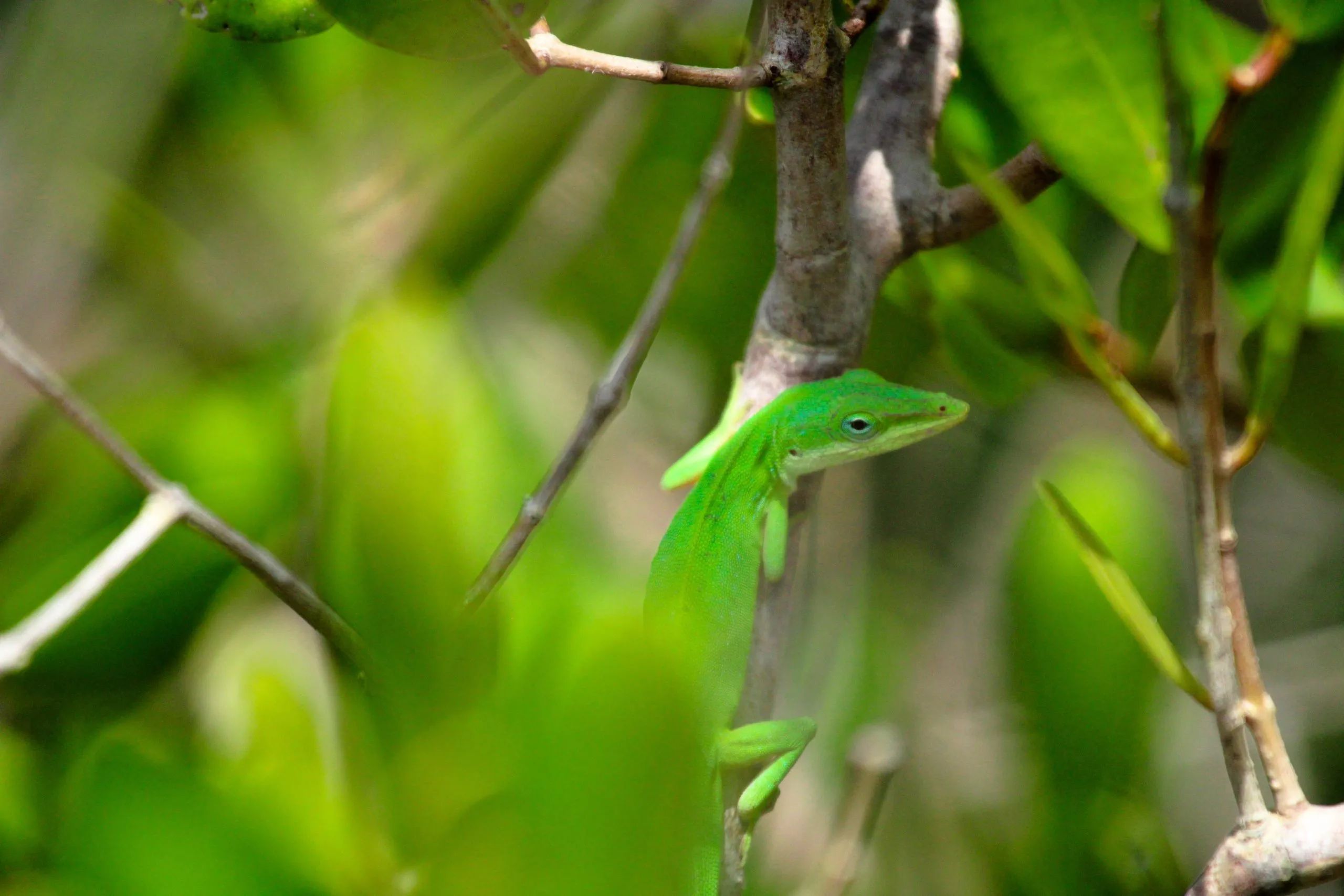
Green anoles are likely to breed in captivity if the conditions are favorable and similar to those in their natural habitat. However, this can be quite challenging for pet owners.
It is recommended to mimic the natural seasonal variations by inducing cyclical environment changes. You’ll have to provide your pets with a 6-week-long winter by reducing the temperature, as well as the humidity and light levels in their terrarium.
During the day, you can keep the temperature at around 81 degrees Fahrenheit and allow it to drop to 62-68 degrees during the night. Moreover, the daytime length should be reduced to 8-10 hours.
Once the “artificial winter” is over, gradually return to the usual terrarium conditions and stimulate the reptiles with various
If your green anoles mate once, females will lay eggs for the remaining season and even store sperm for the next season.
Green Anole Egg Care Checklist/ Shopping List
You can print the checklist below to ensure you’ve got everything covered.
Upon thorough research, which included customer reviews, we’ve compiled some product recommendations you can check out while preparing for the incubation of your green anole eggs.
- Incubator – Reptibator Egg Incubator
- Plastic box/deli cups/Tupperware container – DuraHome Plastic Cups
- Substrate – Josh’s Frogs Vermiculite
- Pencil
- Spoon
- Thermometer + Hygrometer – REPTI ZOO Hygrometer
- Incubator heater/ceramic heat emitter – Little Giant Incubator Air Fan with Heater; Fluker’s Ceramic Heat Emitter
- UVB light lamp – ReptiSun 5.0
- Candle tester – Magicfly Rechargeable Wireless Egg Candle Tester
- Nursing
tank – Zilla 10 Gallon Pet Reptile Starter Kit - Dropper (for keeping the babies hydrated) – EZY Dose Ear and Eye Dropper
- Food sources for baby anoles – Fluker’s Dried Crickets
- Enchi Ball Python: A Unique and Stunning Morph of Python regius - March 27, 2025
- Emerald Tree Monitor: The Enigmatic Green Guardian of the Rainforest - March 26, 2025
- The Egyptian Cobra (Naja haje): A Fascinating Serpent - March 25, 2025
